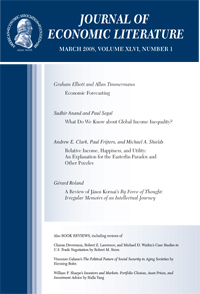工业化前和工业化早期的流行病、不平等和贫困
IF 11.5
1区 经济学
Q1 ECONOMICS
引用次数: 11
摘要
最近的研究探讨了历史上重大流行病的分配后果,而当前由COVID-19引发的危机促使我们回顾过去,了解大流行病如何影响收入、财富和健康不平等。人们通常认为,14世纪的黑死病导致了经济不平等的显著减少,这引起了最大的关注。然而,如果考虑到其他流行病,情况就复杂得多。这篇文章涵盖了前工业时代最严重的流行病,从540-41年的查士丁尼瘟疫到17世纪欧洲最后几次大瘟疫,以及19世纪的霍乱。它表明,致命流行病的分配结果不仅取决于死亡率,而且受到一系列因素的影响,其中主要是每次危机开始时的体制框架。然后,它探讨了过去的流行病是如何影响贫困的,认为高度致命的流行病可以通过两种截然不同的机制来减少其流行:向穷人重新分配或消灭穷人。报告最后回顾了致命流行病的逐渐减弱和间隔时间与预期寿命的提高之间的历史联系,并讨论了流行病如何影响健康和生活水平方面的不平等。(jl d31, i12, i14, i30, n30, j11, j31)本文章由计算机程序翻译,如有差异,请以英文原文为准。
Epidemics, Inequality, and Poverty in Preindustrial and Early Industrial Times
Recent research has explored the distributive consequences of major historical epidemics, and the current crisis triggered by COVID-19 prompts us to look at the past for insights about how pandemics can affect inequalities in income, wealth, and health. The fourteenth-century Black Death, which is usually believed to have led to a significant reduction in economic inequality, has attracted the greatest attention. However, the picture becomes much more complex if other epidemics are considered. This article covers the worst epidemics of preindustrial times, from the Plague of Justinian of 540–41 to the last great European plagues of the seventeenth century, as well as the cholera waves of the nineteenth. It shows how the distributive outcomes of lethal epidemics do not only depend upon mortality rates, but are mediated by a range of factors, chief among them the institutional framework in place at the onset of each crisis. It then explores how past epidemics affected poverty, arguing that highly lethal epidemics could reduce its prevalence through two deeply different mechanisms: redistribution toward the poor or extermination of the poor. It concludes by recalling the historical connection between the progressive weakening and spacing in time of lethal epidemics and improvements in life expectancy, and by discussing how epidemics affected inequality in health and living standards. (JEL D31, I12, I14, I30, N30, J11, J31)
求助全文
通过发布文献求助,成功后即可免费获取论文全文。
去求助
来源期刊

Journal of Economic Literature
ECONOMICS-
CiteScore
17.80
自引率
0.80%
发文量
49
期刊介绍:
Commencing in 1969, the Journal of Economic Literature (JEL) serves as a vital resource for economists, offering a means to stay informed about the extensive literature in the field. Each JEL issue features commissioned, peer-reviewed survey and review articles, book reviews, an annotated bibliography categorizing new books by subject, and an annual index of dissertations from North American universities.
 求助内容:
求助内容: 应助结果提醒方式:
应助结果提醒方式:


